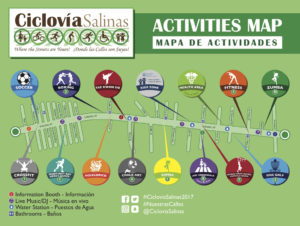by Matthew Donohue
The All-America City of Salinas, California is committed to improving equity, building trust and empowering youth leadership to achieve a shared vision of success.

Like many cities across America, Salinas has grappled with a legacy of segregation and has had to deal with the tragedies of gang and youth-related violence, yet Salinas has made substantial progress in recent years. While the combined dedication of Salinas residents has contributed to a more vibrant, inclusive city, one project in particular, Ciclovía Salinas, has produced surprisingly far-reaching benefits by improving public health, generating economic vitality, developing youth leadership, and above all, cultivating a better-connected and more robust community.
‘Ciclovía’ is a Spanish term for permanently designated bike paths or for streets temporarily blocked off to better accommodate cyclists and pedestrians. In 1974, Colombia’s capital city of Bogota was the first city to close streets for Ciclovías. Bogota’s innovative and cost-effective approach to improve community health has inspired a global array of city-based ciclovías designed to promote public health and community interaction by encouraging residents to walk or bike more frequently.
In 2012, 15 students from Alisal High School came together to propose a project called Ciclovía Salinas. They were inspired by the success of Bogota’s ciclovía when they learned about the story in school and they saw real potential to improve life in their city. Ciclovía Salinas is unique as the first and only open streets project that is youth-led. Since its original inception, Ciclovía Salinas has grown its own cycle of youth internships, led and sustained by interns and volunteers from the previous year. Ciclovía Salinas includes creative, musical, and performance art lining the blocked-off thoroughfare, as well as local, health-conscious food vendors, dieticians from hospitals and Universities, and a wide array of sports teams and exercise classes that not only promote health and wellness on the day of the event, but educate and encourage residents to commit to leading a healthier life. Free immunizations are offered, local nonprofits groups join to present their services and local businesses are prioritized to grow community pride and shopping local. Ciclovía Salinas addresses five goals:
- showcase the valuable assets of Salinas to improve the perception of the city;
- promote health and well-being;
- physically unite the community, which has been historically segregated;
- boost the local economy along the route; and
- foster youth leadership development.
Ciclovía Salinas is supported by the California Endowment’s Building Healthy Communities project and the City of Salinas. Students put in extraordinary effort to attend city council meetings, obtain licenses and permit approvals, make radio appearances and reach out to residents to raise publicity. Ciclovía Salinas would not have been possible without city officials who valued the initiative of high school students. A significant key of Ciclovía Salinas’ sustainability is the dedication of former youth leaders to return as mentors for the next year’s Ciclovía.
Ciclovía Salinas has made extensive progress on their goalto physically unite the community, which has been historically segregated. Over the course of the 20th century, Spanish-speaking migrant farm workers also made their home in Salinas, encouraged to work seasonally under the federal Mexican Farm Labor, or Bracero, programs of 1917-1921 and 1942-1964. These migrant workers were forced to settle in labor camps on the East Side of Salinas, called the Alisal. The central business district in what is now Salinas’ South Side grew very differently from the Alisal. Salinas, like many American cities, has long suffered from a history of racial discrimination and segregation, yet has made significant progress, partly thanks to greater Latino representation in the City Council. According to a 2003 report by the local newspaper, Monterrey County Now,
Until 1989, Salinas City Councilmembers were elected ‘at-large.’ There were no separate districts – as there are now – in which candidates are chosen to represent their neighborhoods.
Recognizing this historical context, the youth specifically selected a 1.6 mile stretch of Alisal St. that connects the hearts of both the East and South Sides. Ciclovía Salinas has transformed this corridor into a bridge, one that helps residents learn more about each other’s culture, and links the two communities in ways which will continue to produce meaningful interactions and lasting partnerships in order to address Salinas’ long-standing challenges. By bridging the two sides of town, the disparities could not be ignored. There are less parks and open space on the East Side for residents to recreate outdoors, and more open space to recreate on the South Side. More infrastructure updates and housing improvements on the South Side that greatly benefited from a Vibrancy Plan. Salinas is now in the process of creating a Vibrancy Plan specifically for Alisal area. Although many groups are coming together for this planning process, Ciclovía Salinas has been a great catalyst to move the process forward.
While all ciclovías succeed in promoting health and civic vitality in their host cities, Salinas has truly benefitted from the creative energy, keen awareness, and deep commitment of young leaders who care about their city. They have built Ciclovía Salinas into a powerful tool that not only erodes physical barriers and barriers of understanding between neighborhoods, but also celebrates the bright culture and warm-hearted people that have defined the beauty of Salinas.



